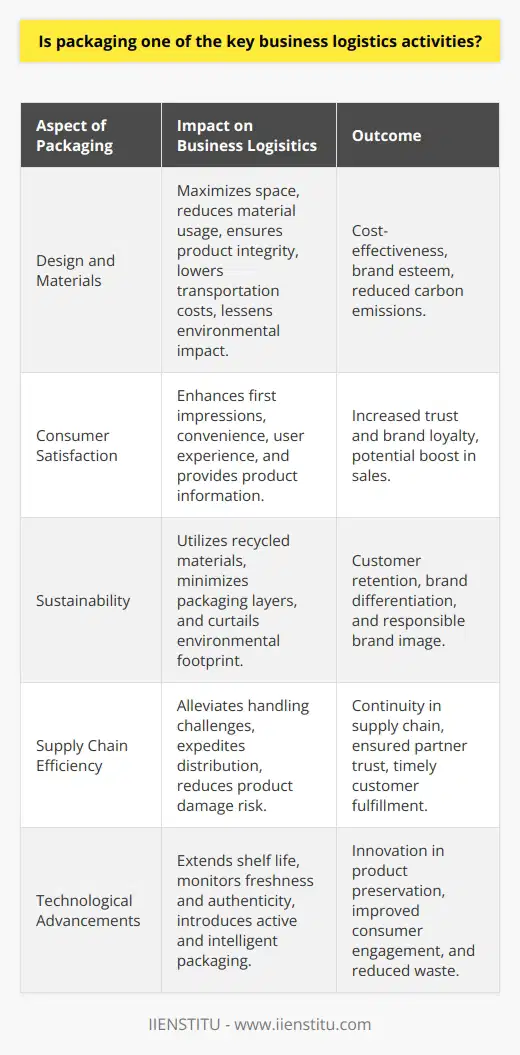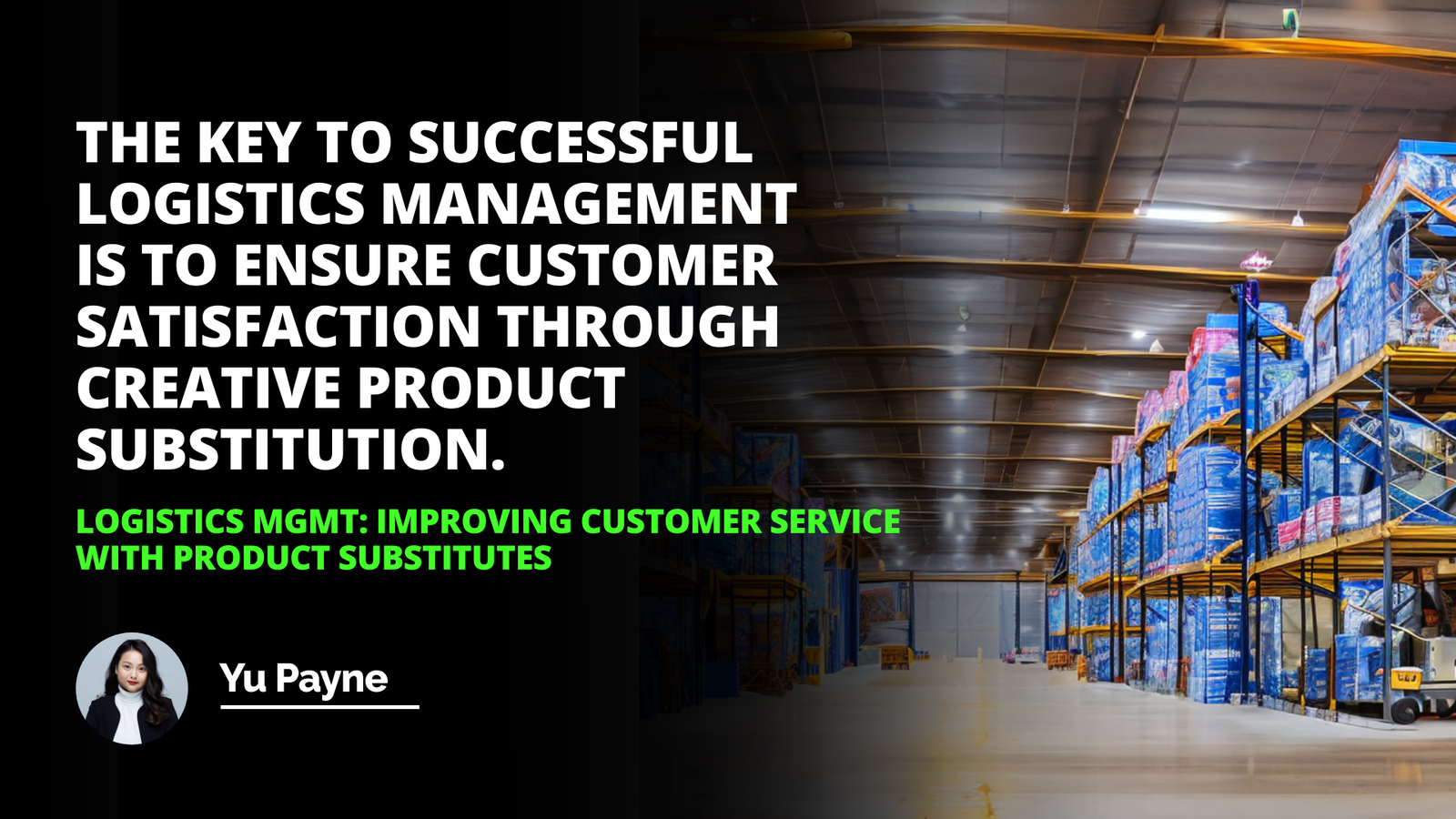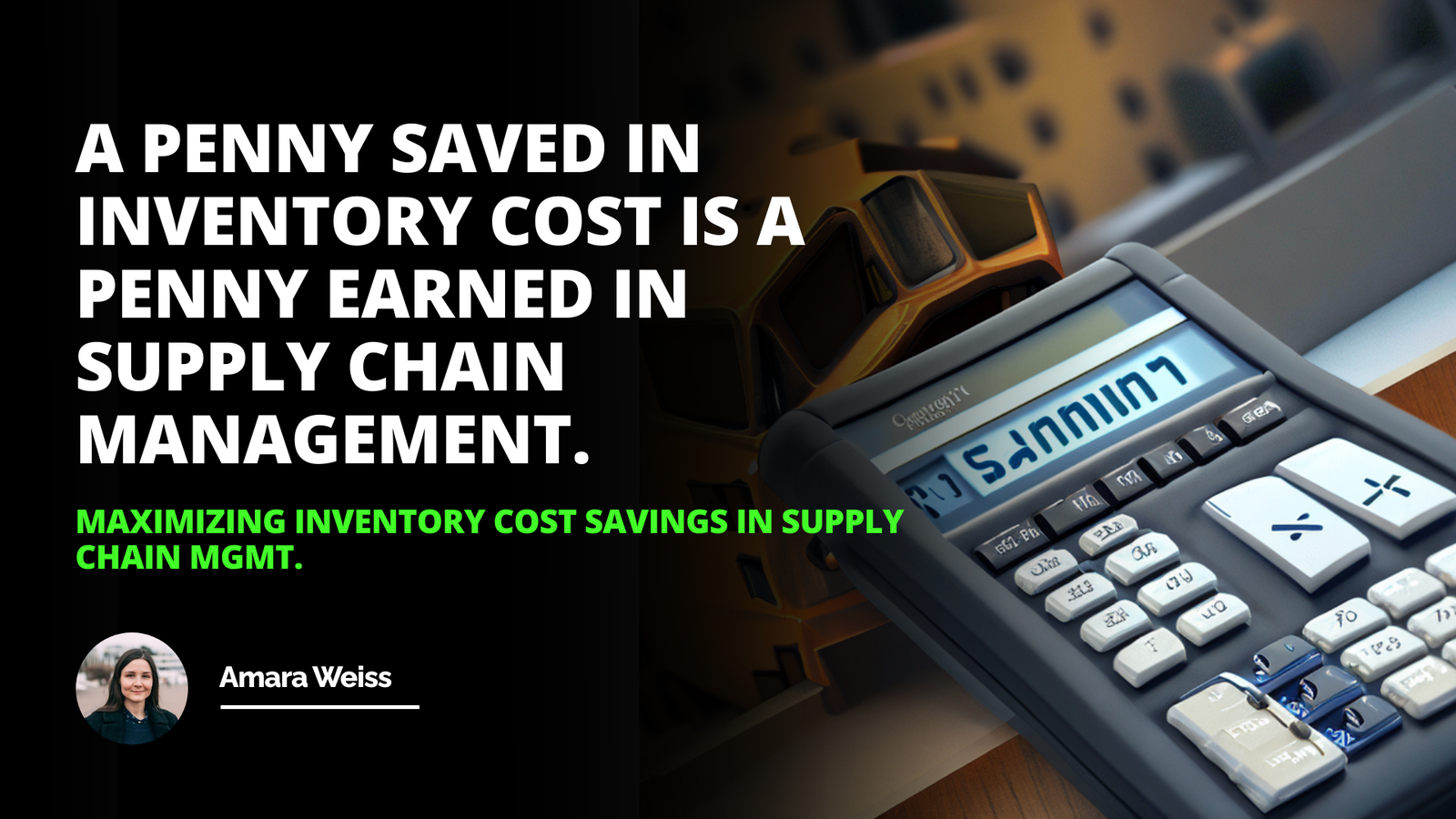
This article discussed what Logistical Packaging is, the benefits of using it, and the challenges associated with it. Logistical packaging is an essential element of a product's physical distribution that can help reduce costs, minimize product damage, and speed up the process of loading and unloading products. However, some challenges are associated with it, such as the cost of the packaging materials and techniques and the time taken to plan and implement the packaging.
Introduction
What is Logistical Packaging?
Benefits of Logistical Packaging
Challenges of Logistical Packaging
Conclusion
Introduction: Logistical packaging is an essential element of the physical distribution of a product, and it can significantly impact the efficiency of the logistical system. While product packaging is based on marketing objectives, logistical packaging is focused on ensuring that products are protected from damage, easy to handle, and occupy minimal storage space. In this article, we will explore what logistical packaging is, the benefits of using it, and the challenges associated with it.
What is Logistical Packaging?
Logistical packaging involves using packaging materials and techniques to ensure that products are transported and stored in the most efficient way possible. This includes using containers, pallets, and crates to facilitate the movement of goods from one place to another. Logistical packaging also includes labels, barcodes, and other tracking systems to ensure that products are tracked throughout the supply chain.
Benefits of Logistical Packaging
Logistical packaging can provide several benefits to businesses. Firstly, it can help reduce transportation and storage costs, as products can be stored in more efficient ways. It can also help reduce the risk of damage to products, as they can be packaged to minimize the risk of injury. Additionally, logistical packaging can help to reduce the time taken to load and unload products, as they can be easily and quickly moved.
Challenges of Logistical Packaging
Despite the many benefits of logistical packaging, some challenges are also associated with it. One of the main challenges is the cost of packaging materials and techniques. As a result, logistical packaging can be expensive and a significant obstacle for businesses. Additionally, logistical packaging can be time-consuming, as it requires careful planning and consideration of the transported products.
Conclusion
Logistical packaging is an essential element of the physical distribution of a product, and it can significantly impact the efficiency of the logistical system. It can provide businesses with several benefits, such as reduced transportation and storage costs, reduced risk of product damage, and reduced loading and unloading times. However, there are also some challenges associated with logistical packagings, such as the cost of the packaging materials and techniques and the time taken to plan and implement the packaging.
Property packaging is the foundation of successful logistics management.
Related Course: Logistics Certificate Programs
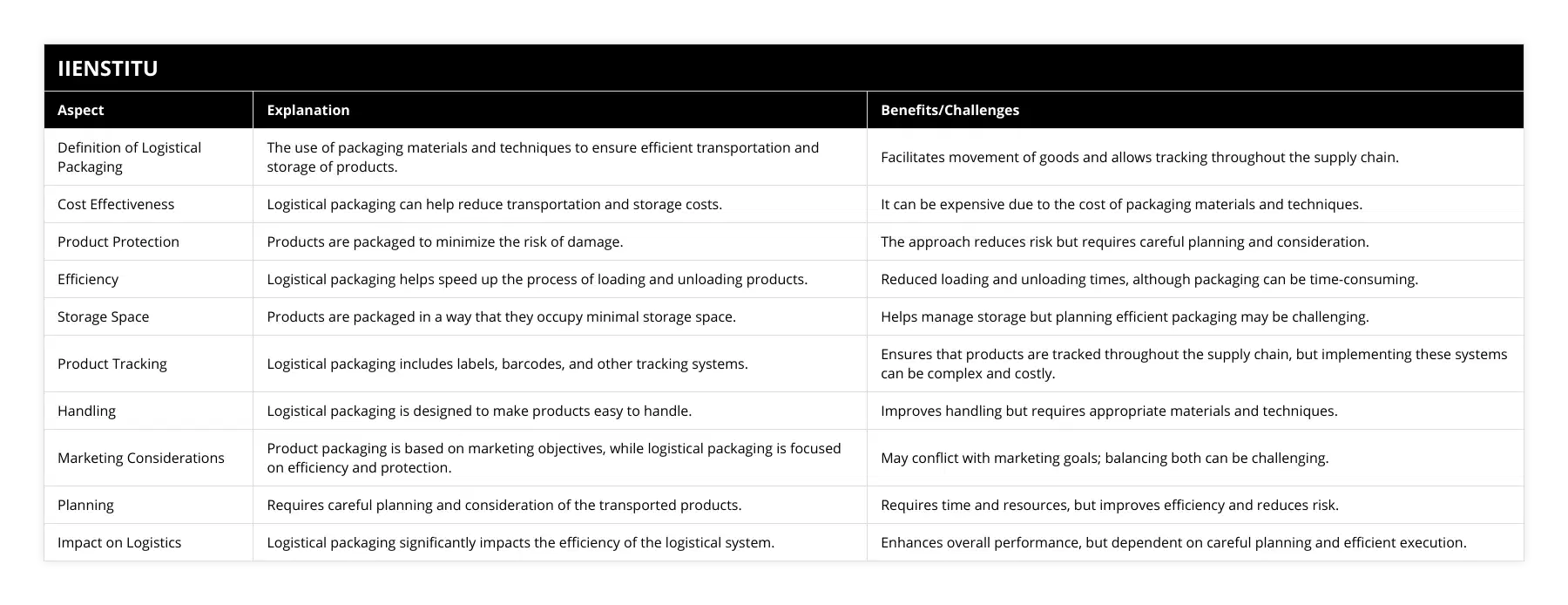
Frequently Asked Questions
What are the main benefits of Logistical Packaging?
Logistical packaging is an integral part of any supply chain, as it helps to ensure that the goods arrive in the best possible condition and on time. In this article, we will discuss the main benefits of logistical packaging and how it can help improve the supply chain's efficiency.
The first benefit of logistical packaging is that it can help reduce transportation costs. Logistical packaging is designed to minimize the environmental impact and ensure that the goods are not damaged during transit. This means that the shipping cost is reduced, which reduces the overall cost of the supply chain.
Second, logistical packaging can help to improve the security of the goods. Logistical packaging ensures that the goods remain secure during transit. This is important, as it can help to prevent theft or damage. In addition, it can provide additional protection against environmental factors, such as temperature, humidity, and pressure.
Third, logistical packaging can help improve the supply chain's efficiency. Logistical packaging can help reduce the time needed to transport goods and the number of trips that must be made. This can help reduce the overall cost of the supply chain and help ensure that the goods arrive on time.
Finally, logistical packaging can help to reduce the risk of product damage. Logistical packaging ensures that the goods are packaged appropriately, which can help reduce the risk of injury. This can help to reduce the number of returns and refunds that must be made and can also help to ensure that the goods arrive in the best possible condition.
In conclusion, logistical packaging is an essential part of any supply chain. It can help to reduce the cost of transportation, improve the security of the goods, improve the efficiency of the supply chain, and reduce the risk of product damage. By utilizing the benefits of logistical packaging, companies can ensure that their supply chain is efficient and cost-effective.

What challenges are associated with Logistical Packaging?
Logistical packaging is integral to the supply chain process and protects goods during transportation. Therefore, companies must utilize the proper packaging to ensure the safe delivery of their goods to their customers. However, there are challenges associated with logistical packaging that must be addressed for companies to deliver their products successfully.
One of the main challenges associated with logistical packaging is the cost associated with packaging materials and labor. Packaging materials can be expensive, especially when they are high quality and must be purchased in bulk. Additionally, labor costs can add to the overall cost of logistical packaging. Therefore, companies must ensure that they are utilizing the most cost-effective packaging materials and labor resources to minimize the cost of packaging.
Another challenge associated with logistical packaging is the environmental impact it has. Packaging materials are often non-biodegradable and can hurt the environment. Therefore, companies must consider the ecological considerations of their packaging and ensure that their packaging is as sustainable as possible. This includes using packaging materials made from recycled materials, using biodegradable materials, and taking measures to reduce the amount of packaging used.
Finally, logistical packaging must be tailored to the specific needs of the goods transported. Packaging materials must be chosen based on the transported goods' size, shape, and weight. Additionally, packaging must protect the interests from damage during transportation, including from weather and other external factors. Companies must also consider the regulations of the countries they are shipping to ensure that their packaging meets all requirements.
In conclusion, logistical packaging poses several challenges that must be addressed for companies to deliver their goods safely and cost-effectively. Companies must carefully consider the cost, environmental impact, and specific packaging requirements to ensure that it suits their interests. By understanding and addressing these challenges, companies can ensure that their packaging is as effective and cost-efficient as possible.
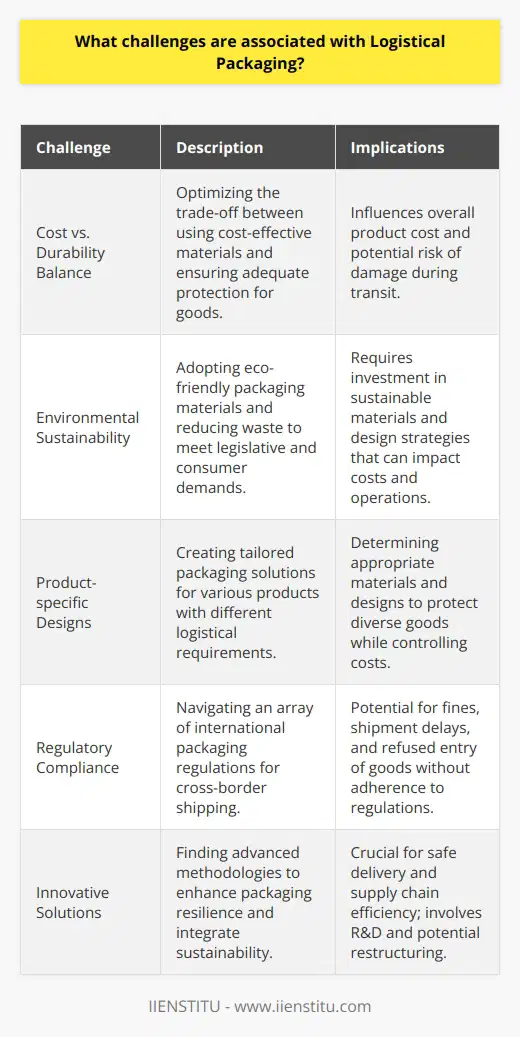
How can Logistical Packaging help improve logistics management?
Logistical packaging is an integral part of successful logistics management. It involves selecting and implementing packaging materials and designs that can effectively protect goods, optimize space utilization, and facilitate efficient transportation. By optimizing logistical packaging, businesses can reduce their costs, minimize the risk of damaged goods, and improve overall customer satisfaction.
The selection of the appropriate packaging materials and designs is essential for effective logistics management. The packaging must protect the goods from potential damage during transportation and storage. In addition, the packaging must be designed to maximize space utilization, which can help reduce the costs associated with transportation and storage.
Once the appropriate packaging materials and designs have been selected, businesses must ensure their implementation. This means the packaging must be correctly applied to the goods and labeled appropriately to provide efficient transport. To ensure proper performance, businesses should conduct regular packaging audits to identify potential issues.
In addition to selecting and implementing the appropriate packaging materials and designs, businesses should also consider using packaging technologies. Technologies such as automated and intelligent packaging systems can help reduce operational costs, increase operational efficiency, and improve customer satisfaction. Mechanical packaging systems can help streamline the packing process, while smart packaging can provide businesses with real-time data about their shipments.
Finally, businesses should consider using sustainability initiatives in their logistical packaging. This includes selecting packaging materials that are recyclable and biodegradable and implementing packaging designs that are designed to minimize the use of unnecessary materials. Implementing sustainability initiatives can help businesses reduce their environmental impacts and improve their public image.
In conclusion, logistical packaging plays an essential role in successful logistics management. By selecting and implementing the appropriate packaging materials and designs, businesses can reduce costs, minimize the risk of damaged goods, and improve overall customer satisfaction. Furthermore, companies should consider using packaging technologies and sustainability initiatives to optimize their logistical packaging further.

Why is packaging important in logistics management?
Significance of Packaging
Packaging plays a crucial role in logistics management by ensuring that products are protected, preserved, and transported efficiently. It serves as a fundamental component for maintaining the product's quality and promoting a favorable brand image.
Preventing Damage and Contamination
One key aspect of packaging is to prevent any damage or contamination during transportation and storage. The selection of appropriate materials and techniques for packaging safeguards products from potential hazards, such as extreme temperature, moisture, pests, and impact. By doing so, businesses can reduce losses and maintain the integrity of goods.
Efficient Transportation and Storage
Packaging design also influences transportation and storage efficiency. Strategically designed packages allow for optimal stacking and space utilization, which leads to lower transportation costs and warehousing requirements. Furthermore, standardized packaging enables streamlined handling and processing of shipments, minimizing delays and errors in the supply chain.
Customer Experience and Branding
An effective packaging does not only protect the products but also serves as an essential marketing tool. It enhances customer experience through product presentation and ease of use, ultimately influencing their purchase decision. Additionally, packaging design reflects a company's identity and values, contributing to its overall brand image.
Environmental Considerations
In recent years, the environmental impact of packaging has become increasingly relevant for logistics management. Sustainable packaging materials and practices not only help in reducing a company's environmental footprint but also provide an appealing selling point to eco-conscious consumers. As a result, businesses need to adopt eco-friendly solutions, such as recyclable and reusable materials, to stay competitive within the market.
Regulatory Compliance
Finally, packaging plays a vital role in adhering to industry regulations and legal requirements. It ensures products are safely delivered following specific guidelines, such as labeling standards, hazardous material restrictions, and import/export regulations. Compliance with these regulations is critical to avoid legal ramifications, potential fines, and damage to a company's reputation.
In conclusion, packaging serves multiple purposes within logistics management by securing the product's quality, optimizing transportation and storage processes, promoting a strong brand image, meeting environmental and regulatory considerations. A well-executed packaging strategy enhances overall business performance and ensures customer satisfaction, making it indispensable for successful logistics management.
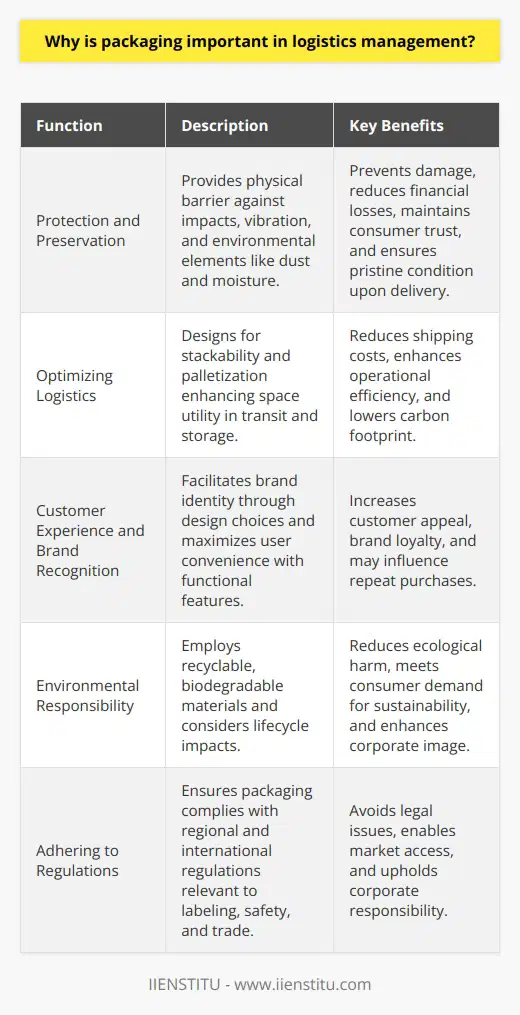
What is packaging in logistics management?
Logistics Management Overview
Logistics management is a crucial function in businesses, involving the planning, execution and control of goods flow from the point of origin to the point of consumption. It entails critical aspects, such as warehousing, transportation, and distribution. A vital component of logistics management, packaging, serves different purposes in the whole supply chain process.
Functions of Packaging
Packaging in logistics management primarily protects the product during transport, handling, and storage, ensuring the consignment reaches the consumer in an acceptable state. Its secondary function includes providing information about the contents and its origin, thereby enhancing traceability and quality control. Packaging also plays a significant role in facilitating efficient handling and transportation of goods, reducing the overall logistics cost.
Materials Utilization and Cost Efficiency
The choice of packaging material depends on the nature, dimension, and the fragility of the product. Materials such as cardboard, plastic, and polymers serve various purposes while optimizing cost and usage efficiency. In addition, eco-friendly packaging options are becoming increasingly popular, given their potential to reduce the company's carbon footprint, contributing to a sustainable supply chain.
Innovations in Packaging Technologies
Technological advancements are shaping the way businesses approach packaging in logistics management. Innovations such as smart packaging, active packaging, and sustainable packaging materials are being deployed to achieve operational excellence. For instance, smart packaging integrates technologies like QR codes, radio frequency identification (RFID), and other data-sharing tools to enhance traceability, real-time monitoring, and inventory management.
Role of Packaging in Marketing
Aside from logistics, packaging can also impact marketing efforts. As the first point of contact between the consumer and the product, attractive and functional packaging can evoke a positive response from potential customers. Brand recognition and positive association can contribute to customer satisfaction, which may translate into increased sales and brand loyalty.
Conclusion
In summary, packaging plays a multifaceted role in logistics management, encompassing protective and informative functions while improving efficiency in the supply chain processes. With the rapid emergence of innovative materials and technologies, packaging continues to evolve, resulting in enhanced product handling, cost reduction, and an increased focus on sustainability. Ultimately, effective packaging approaches can lead to improved overall logistics management and organization success.

Is packaging the key to the logistics value chain?
The Role of Packaging
In the logistics value chain, packaging plays a significant role in ensuring the efficiency and effectiveness of product delivery to end consumers. As a crucial component, it reduces the risk of damage, loss, and contamination, thereby maintaining the quality and integrity of products during transportation and storage.
Increased Efficiency through Proper Packaging
One way packaging contributes to the logistics value chain is by increasing efficiency. Appropriate packaging materials and designs help in optimizing space utilization in trailers, containers, and warehouses. Moreover, efficient packaging solutions can lead to lower transportation costs and faster transit times, ultimately improving the overall supply chain performance.
Quality and Safety Implications
Packaging also plays a key role in retaining product quality and safety. It serves as the first line of defense against potential external threats, such as impacts, temperature fluctuations, and moisture ingress. Protective packaging can prevent degradation or contamination, ensuring the product delivered to the end user is in the same condition as it was when dispatched from the manufacturing facility.
Environmental Concerns and Sustainable Solutions
While packaging is essential in the logistics value chain, it is also important to consider its environmental implications. The utilization of environmentally friendly materials, such as biodegradable plastics or recycled materials, can significantly reduce the ecological footprint associated with packaging disposal. Furthermore, implementing sustainable packaging solutions can enhance a company’s commitment to corporate social responsibility, bolstering its brand reputation and fostering customer loyalty.
Embracing Innovation to Improve Logistics Value Chain
Innovation in packaging materials, designs, and technologies can yield notable improvements in the logistics value chain. Smart packaging, for instance, has the potential to enhance supply chain visibility by incorporating sensors, RFID tags, or other tracking tools. These advancements can improve inventory management, reduce spoilage, and detect potential issues during transportation, elevating overall operational efficiency.
In conclusion, packaging is undeniably an essential element in the logistics value chain. It safeguards products, contributes to increased efficiency, and can serve as a driving force for innovation. As such, companies should carefully consider their packaging strategies and embrace sustainable and technologically advanced solutions to ensure optimal performance within the logistics realm.

What are the 4 key processes in logistics?
Logistics Management Processes
There are four main components that underlie the logistics processes. These are supply chain management, transportation, inventory management, and warehousing. These critical processes ensure the efficient and effective flow of goods and resources from the point of origin to the point of consumption.
Supply Chain Management
Supply chain management encompasses planning and managing all activities involved in sourcing, procurement, conversion, and logistics management. It is an important part of the overall logistics framework, aimed at creating seamless integration of various activities to facilitate the movement of goods, information, and financial transactions.
Transportation
Transportation plays a key role in the efficient movement of goods and materials from one point to another. It includes various modes, such as road, rail, air, and sea, to facilitate movement through the supply chain. Effective transportation management ensures that shipments are delivered in a timely and cost-effective manner, minimizing disruptions to the supply chain.
Inventory Management
Inventory management deals with the control and tracking of goods throughout the supply chain to minimize lead times, reduce storage costs, and maintain optimum stock levels. It includes activities such as forecasting, demand planning, and stock control, which help organizations to manage their inventory effectively and efficiently. This ensures that sufficient quantities of goods are available to meet customer demand while avoiding overstocking and stock shortages.
Warehousing
Warehousing involves the storage and handling of goods within a facility, as well as the tracking, retrieval, and dispatch of these items. Effective warehouse management helps in optimizing storage space, improving product handling, and reducing lead times, contributing to the efficiency of the logistics process. It is vital for organizations to have well-designed and well-managed warehouses to maintain proper inventory levels and ensure a smooth flow of goods throughout the supply chain.
In conclusion, the four key logistics processes - supply chain management, transportation, inventory management, and warehousing - are essential in ensuring the efficient management of goods and resources. By effectively executing these processes, organizations can optimize their supply chain operations, reduce overall costs, and improve customer satisfaction.
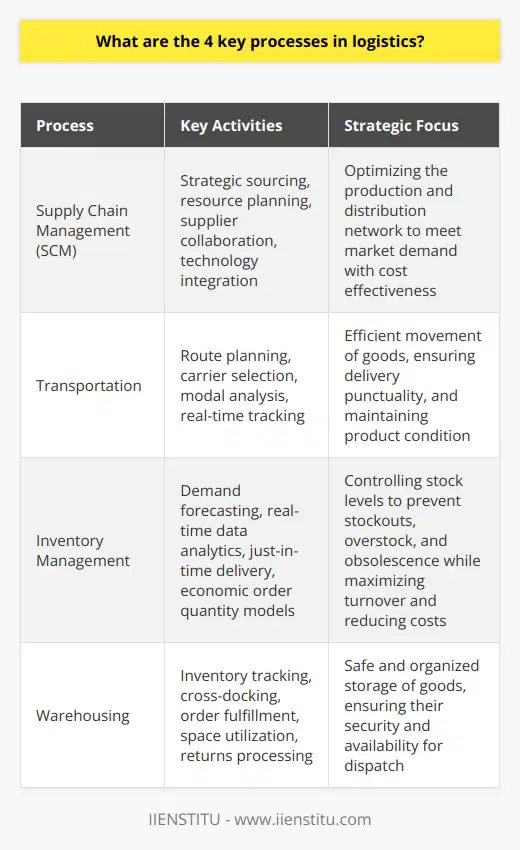
How does packaging contribute to the efficiency of logistics management?
Packaging's Role in Efficient Logistics Management
Strengthening Product Protection
Packaging plays a vital role in logistics management by providing necessary protection to products during transportation. It prevents damage and ensures that goods arrive at their destination in optimal condition. By selecting appropriate packaging materials, companies can minimize product losses, which in turn helps to reduce overall costs and ensure customer satisfaction.
Enhancing Storage and Transportation Efficiency
Furthermore, packaging contributes to the efficiency of logistics management by enabling the effective storage and transportation of goods. Efficient packaging designs maximize the use of available space in warehouses and reduce the need for additional storage facilities, thereby lowering overhead expenses. Moreover, when products are packaged in uniform shapes and sizes, they are easier to handle, load, and transport, further streamlining the logistics process.
Simplifying Product Identification and Tracking
Additionally, packaging serves as a means of identifying and tracking products throughout the supply chain. This is achieved through the use of labels, barcodes, or Quick Response (QR) codes that provide relevant information about the products, such as type, expiry date, and batch number. This information allows logistics personnel to efficiently manage inventory, track shipments, and maintain precise records, which can lead to improved demand forecasting and order fulfillment.
Supporting Sustainability Initiatives
Lastly, sustainable and eco-friendly packaging designs can help companies in their efforts to reduce their environmental footprint and comply with regulatory requirements. By using recyclable and biodegradable materials, businesses can not only contribute to waste reduction but also appeal to environmentally conscious consumers, which can indirectly improve the performance and efficiency of logistics systems.
In conclusion, packaging contributes significantly to the efficiency of logistics management by safeguarding products, enhancing storage and transportation processes, simplifying product identification and tracking, and supporting sustainability initiatives. Companies that invest in strategic packaging solutions are more likely to experience improvements in their overall logistics management systems, resulting in cost savings and greater customer satisfaction.

Is packaging one of the key business logistics activities?
Significance of Packaging in Business Logistics
Undoubtedly, packaging plays a critical role in business logistics, serving multiple essential functions for product distribution and protection. It ensures products reach consumers in an undamaged state and maintains their quality.
Purposeful Design and Materials Selection
An integral aspect of packaging is the careful design and selection of materials, which directly contribute to the efficiency of transportation, storage, and handling processes. Optimal packaging materials minimize costs, reduce the risk of damage, and guarantee optimal space utilization during transportation.
Increasing Consumer Satisfaction
Moreover, packaging influences consumer satisfaction, as it provides essential information about the product, assists in making a purchase decision, and contributes to the overall aesthetics of the product. Consequently, packaging significantly impacts brand image, competitive advantage, and customer loyalty.
Driving Sustainability Efforts
With the growing importance of sustainability in business, companies must strive for eco-friendly packaging solutions to reduce their environmental footprint. For instance, businesses can adopt biodegradable materials and minimize packaging waste, helping conserve natural resources and reducing long-term costs.
Streamlining Supply Chain Processes
Effective packaging also contributes to the seamless flow of goods through the supply chain, as it is designed to accommodate various handling and storage arrangements. This way, companies can maintain their efficiency, speed, and reliability, all of which are vital in meeting the needs of businesses and end-users.
Advancements in Packaging Technology
Recent innovations in packaging technology offer various opportunities for businesses to enhance their logistical operations. Developments like active and intelligent packaging systems contribute to product safety, preservation, and shelf life extension, thereby complementing companies' supply chain strategies.
In conclusion, packaging is undeniably an essential aspect of business logistics, as it performs various critical functions in areas such as transportation, storage, product protection, and customer satisfaction. By continually improving their packaging designs and strategies, businesses can optimize their logistical operations, maintain their competitive advantage, and meet the evolving demands of the market.
